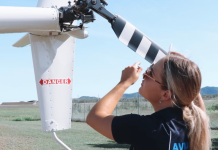When the system that controls a helicopter’s engine RPM becomes unreliable, the result can be an uncomfortable period of in-flight anarchy.
The pilot was taken by surprise, but to their credit, not for long. From straight and level flight, the Robinson R22 began to yaw until after about 2 seconds, it was crabbing at about a 45-degree angle. The movement was not violent or aggressive but it was uncommanded.
Without hesitation, the pilot took the optimum action to counter loss of tail rotor effectiveness and lowered the collective to enter autorotation, lifting it slightly a heartbeat later to control rotor rpm in accordance with their training. However, the high rpm horn continued its deliberately unsettling tone. In the stress of the moment the pilot was briefly unsure which horn was screaming – was it high or low rpm? But training kicked in at once and a quick scan of engine and rotor tachs revealed the truth. Both were above redline.
The pilot instantly tried to rectify this by manually overriding the twist grip throttle on the collective pitch control, rolling it off to get the tachs back into their green zones. The throttle kept wanting to roll on and the pilot had to maintain a firm grip to control it.
After about a minute of this intermittent struggle, the pilot switched off the governor and controlled the sensitive throttle by hand for the remainder of the flight.
Search for answers
Helicopter pilots need certain qualities to a greater degree than do fixed-wing pilots of similar sized aircraft. One of these requirements is quick response, which is vital when flying low-inertia main rotor designs such as the Robinson R44 and particularly the Robinson R22.
Fixed-wing pilots require a subtly different state of alertness. In any situation other than a low-height emergency in take-off or landing, judgement is often improved by taking and releasing a deep breath and spending a few seconds analysing the apparent problem. Pilots of small helicopters do not have this luxury. But governor failure is near the bottom of the long list of operational, weather and mechanical factors that can endanger flight in small helicopters. Until recently, it had been a reliable component in Robinson designs.
Helicopter main rotors have a narrow band of efficient and safe operation. If turning too fast, they risk failure from the centrifugal forces generated. If turning too slowly they do not generate enough lift.
A governor is an electronic device that senses rotor and engine rpm and makes the necessary adjustments to keep rotor rpm constant. In normal operations the governor keeps the rpm constant and the pilot does not have to make any throttle adjustments.
All turbine helicopters and many modern piston helicopters use governors. Some older piston helicopters, including early versions of the Robinson R22, used a mechanical device called a correlator that connected the collective lever and the throttle. When the collective lever was raised, power was automatically increased, and decreased when the collective was lowered. This system maintained rpm close to the desired value, but required minor adjustment of the throttle, adding to the pilot’s workload.
The 2023 incident was the latest in a series that had already prompted Robinson Helicopter Company to issue a safety alert in February 2022. The Australian Transport Safety Bureau (ATSB) published a media release on the same day. This was followed by CASA Airworthiness Bulletin AWB 67-006 Issue 1, quickly superseded by Issue 2 on 16 February 2022, and by US Federal Aviation Administration airworthiness directive AD 2022-12-08 on 14 June 2022.
The Robinson bulletin said, ‘Recently, there have been occurrences where governor malfunction was not recognised by the pilot in time to prevent an overspeed or an unsafe low-rpm condition. The governor has been extremely reliable to the point that some pilots trust it without guarding against malfunction. Malfunctions can and do occur on any aircraft system and pilots need to consciously monitor system operation.’
The ATSB release focused on reported incidents. It said, ‘A small number of recent incidents have been reported to both the ATSB and to the Civil Aviation Safety Authority (CASA) where the governor has not controlled engine rpm under normal conditions.’
The release quoted ATSB Chief Commissioner Angus Mitchell, who said, ‘This has led to either a rotor overspeed or underspeed condition, requiring the pilot to override the governor by applying collective throttle inputs.’
CASA said, ‘Several cases have been reported of the governor not controlling engine rpm under normal conditions leading to either a rotor overspeed or underspeed condition.’
The FAA airworthiness directive said, starkly, ‘This AD was prompted by reports of intermittent or abnormal operation of the governor.’
Issue and solutions
In January 2020 Robinson had introduced a running change on its R22 and R44 models. An engine monitoring unit which is a digital recording device within the governor controller was now standard. This electronic device monitors engine and rotor speed, various temperatures and pressures for download to a computer with the appropriate software (summaries may be viewed on an app) and would issue flashing alerts if it detected an exceedance of proper values. It was combined with the electronic governor in a housing on the rear wall of the cockpit.
Later in 2020, reports began to arrive at the Robinson factory in Torrance, California from national aviation bodies and investigators around the world telling of a wave of previously rare governor malfunctions. The incidents ranged from curious to unsettling, although no accidents have been reported in association with the condition to date.
In February 2022 Robinson issued service bulletin 119 for the R22 and SB111 for the larger R44. Both bulletins required ‘inspecting the engine-rpm sensor wiring and modifying the wiring connection to the airframe harness with different connectors for improved clearance and strain relief’. Robinson provided a service kit free of charge and the bulletins required the modifications to be done within 5 flight hours from operators receiving them.
However, reports of governor problems have continued, even for aircraft that have undergone the service bulletin program. By July 2022, CASA made a fourth issue of AWB 67-006, ‘prompted by continued reporting of erratic governor controller operation, even on aircraft in a post SB-111 or SB-119 configuration.’
The CASA AWB says, ‘Steel and iron wear particles generated during engine break-in may accumulate on the C143 engine rpm sensor, causing signal interference’.
Robinson expanded its advice, requiring cleaning of the C143 engine rpm sensor in accordance with the procedure given in the latest revision of Robinson service letters SL-94 or SL-83.
CASA’s advice, given in the latest revision of AWB 67-006, is to protect the helicopter from moisture and never use a high pressure hose for cleaning it.
Responses
There are 2 things pilots and operators need to do in response to this ongoing issue.
The first is for pilots to be aware of the increased probability of governor malfunction on post-2020 Robinson helicopters. The manufacturer’s safety alert gives concise instructions:
- Monitor governor operation during flight by keeping hand lightly on throttle twist grip. If twist grip rotation becomes erratic or stops altogether, governor may be malfunctioning. If twist grip rotates steadily open or closed, override promptly to prevent rpm excursion. Note: Do not unintentionally override governor by squeezing throttle twist grip too tightly during normal operation.
- If a governor malfunction is suspected, switch governor off and assume manual rpm control using twist grip.
CASA’s AWB adds, ‘Land as soon as practical’ to this advice and ‘have governor serviced by qualified maintenance personnel’.
The second important countermeasure is for pilots and operators to report any governor problems through the CASA defect reporting system (DRS) and to the ATSB, for occurrences serious enough to warrant classification as an aviation incident. If in doubt, report to both agencies. Robinson Helicopter Company continues to investigate the circumstances of the malfunctions to identify causal factors and solutions.






Comments are closed.